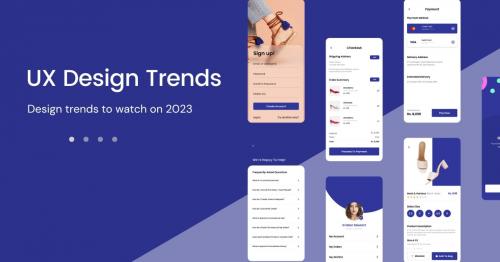10 UX Design Trends to Watch Out for in 2023

User experience (UX) design is a fascinating domain that serves a variety of purposes. From attending to the new demands from users and ensuring the best experience for them to providing brands and businesses with the tools to keep their customers satisfied, UX design plays a pivotal role in the creation of new products, apps, user interfaces, and more.
Keeping up with the constantly evolving trends in UX design can be very tedious. In this blog, we take a look at the latest trends in UI UX design you must watch out for in 2023.
Latest UX Design Trends
In order to establish your dominance in a fast-paced domain, riding on the latest trends is a competitive advantage. Here is a list of the latest UX design trends.
Advanced Cursor Interactions
Advanced cursor interactions allow users to interact with the cursor on their device to perform specific actions. These interactions can include hover states, drag-and-drop functionality, and context-sensitive menus. The goal of advanced cursor interactions is to make the user experience more intuitive and efficient, by allowing users to perform common tasks with less effort and fewer steps.
Data Visualization
Data visualization in UX design makes complex data more accessible and understandable for users, allowing them to quickly identify patterns, trends, and insights. It can help improve the overall user experience by providing a clear and easy-to-understand representation of the data, making it more engaging and interesting for users to interact with.
Micro-interactions
Micro interactions in UX design refer to small, specific interactions between a user and a digital product or service. These interactions can include things like toggling a switch, pulling to refresh, or changing the volume on a media player. They are designed to enhance the overall user experience by providing visual feedback, indicating system status, and making the product more intuitive and easier to use. Micro interactions can be used to create a sense of delight and engagement for users, making the product more enjoyable to use.
Clean User Interfaces
Design your user interface in a way that minimizes distractions and makes it clear what the user needs to do. A clean interface is typically achieved through a combination of good visual design and user-centered design principles. This can include using whitespace effectively, using simple and consistent layout, and providing clear and concise labels and instructions. Additionally, a clean interface should be easy to navigate and provide users with clear feedback on their actions.
Metaverse
Designing for the metaverse involves creating user interfaces and interactions that are natural, intuitive, and seamless for users. It would require creating a sense of presence and immersion for users in the virtual world, and designing for the unique characteristics of virtual environments such as spatial audio, haptic feedback and full body tracking. Some examples of metaverse design include virtual reality social platforms, multiplayer gaming experiences, and virtual marketplaces.
Personalized Experiences
Personalized experiences in UX design are interfaces and interactions that are tailored to the individual needs and preferences of a particular user. This can be achieved through a variety of means, such as personalization algorithms, machine learning, and data analysis. Personalization can help to improve the overall user experience by providing users with content and features that are most relevant to them, and by making interactions more efficient and intuitive.
Dark Mode
Dark mode in UX design services is intended to reduce eye strain and improve visibility in low-light environments, and can be especially useful for users who work at night or in dimly lit spaces. Dark mode can be implemented in both native and web-based applications, and is often found in settings or preferences menus. Enabling dark mode can also help save battery life on devices with OLED or AMOLED screens, as it reduces the amount of power needed to display white pixels.
3D Designs
3D designs in UX design includes elements like 3D buttons, icons, images, and models, as well as more complex animations and interactions. 3D design can be used to create a more immersive and engaging experience for users, and can also be used to make complex information or tasks more easily understandable. 3D designs can help to improve the usability and overall user experience by making interfaces more intuitive, interactive, and memorable.
AI-generated Content
AI can be used to automatically create or generate content for user interfaces. This can include things like text, images, and videos, as well as more complex elements like animations and interactions. AI-generated content can be used to personalize the user experience by providing users with content that is tailored to their interests, preferences, and behavior. Additionally, it is important to consider the ethical implications of using AI-generated content in UX design services, such as the potential for bias or lack of transparency.
Responsive Design
Responsive design in UX design enables a user interface to adapt to the different screen sizes and resolutions of different devices. This is achieved by using flexible layouts, images, and other elements that can adjust to the size and shape of the user's screen. Responsive design is important because it allows users to have a consistent and optimal experience regardless of the device they are using, whether it is a desktop computer, a tablet, or a smartphone. By implementing responsive design, businesses can ensure that their digital products are accessible to all users, and that they provide a consistent user experience across different platforms.
Final Thoughts
The above-mentioned list covers all the latest trends in UX design services. Keeping these in mind when designing a user interface for your website or product will help ensure that you offer your users only the best experiences.
Post Your Ad Here
Comments